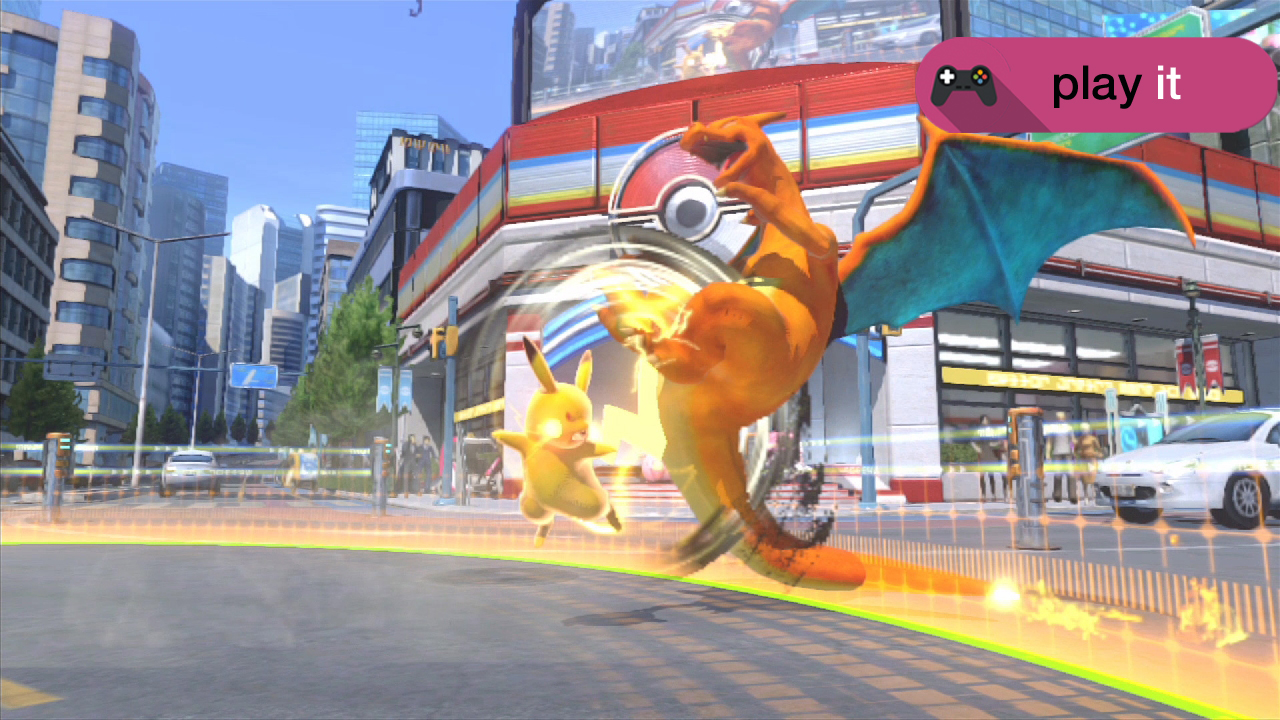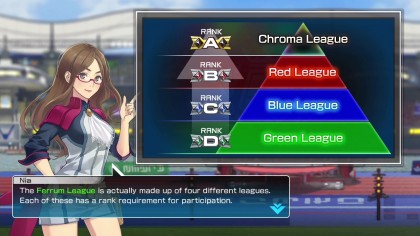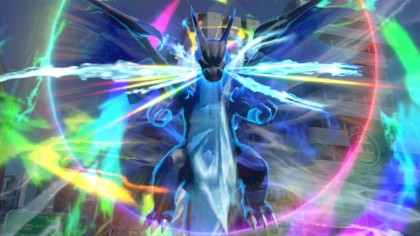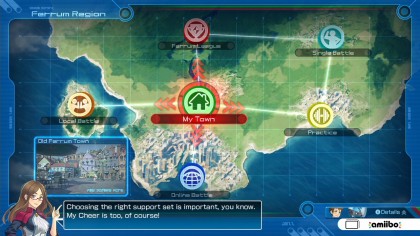Pokkén Tournament review
So you want to be the very best? Good luck with that

The Luchador Pikachu stands upon the ring post as he beckons the crowd into a frenzy, the soundtrack to my demise. Yeah, his wrestling mask is cute, but he's got a look in his eyes that says this little guy, this once-friendly yellow bastard I rescued from the Viridian Forest in Pokémon Blue nearly 20 years ago, is about to Moonsault me – and there's nothing I can do about it. So this is how Pokémon feels from the monsters' perspective.
This is Pokkén Tournament, where you no longer command your monsters from afar but control them directly in battle. Pokkén has generated quite a lot of buzz since appearing in Japanese arcades last year, probably for several reasons: it's a 3D Pokemon game for the Wii U; it's the first beat-em-up title in the entire franchise; and most interesting of all, it's been developed by Tekken creator Bandai Namco.
Each of these elements set different expectations for what Pokkén might be, and though the game started its life as a Tekken engine, it has evolved into something much bigger than just a reskin.
The best thing I can say about Pokkén Tournament is that it has more depth than most players will expect. Sure, at heart it's a best-of-three smackdown built on combos, grabs, and being the first to beat the living Muk out of the other, but Bandai Namco has also thrown in some other interesting elements that dramatically change the dynamics of gameplay - and offer more complexity for those who seek it.
Right now I'd even argue that Pokkén might risk alienating the more casual players. This is a very different game to Super Smash Bros; the differences between the characters in Pokkén are vast, and mastering each one will demand a lot more time and skill.
It's for this reason I suggest rinsing the tutorial process for all it's worth before even moving onto any other single player modes. There's a lot to learn, and the tutorial offers a bite-sized breakdown of what could otherwise be quite an overwhelming introduction to Pokkén.
Oh, and when you have finally got to grips with how battles work, I'd advise switching Nia's advice off in the settings. She's a handy guide at first, but she gets really annoying very quickly.
Sign up for breaking news, reviews, opinion, top tech deals, and more.

Who's who?
Pokkén Tournament has 16 characters right now, and the game has already been criticised for what some consider to be a meagre character roster - Pokémon is a franchise that prides itself on its abundance of creatures - but when you factor in just how varied these Pokémon are and what Pokkén actually wants to be, it stops feeling like such a valid critique.
The characters are a mix of old and new Pokémon generations - old school fans will be glad to know Charizard, Pikachu and Gengar all get a look-in - but if anything Pokkén encourages you to stick with one Main throughout. You can switch your partner Pokémon in the settings at any time you like, but the game doesn't nudge you to try another character. Pokémon also level up using experience gained from every fight; each time they do you can assign a skill point to one of the four stats: Attack, Defense, Strategy or Synergy.
If you're not sure with which character to go for first, each has its own assigned style - standard, power and technical - which should offer some rough guidance.
Phase me
Battles in Pokkén are made up of two phases, the Field Phase and the Duel Phase. The Field Phase begins every round and gives you an over-the-shoulder view of your monster as per traditional Pokémon games. Here you have three-axis movement, and the commands in this phase are more focused on projectiles and homing attacks.
However, once you land an "initiating" hit, play switches to the Duel Phase where you're moved to a horizontal plane in the style of more traditional fighting games. The command buttons also change function at the switch, shifting to more close-combat-style play.

Duel Phase is where you'll be rolling out the combos, grabs and counters to maximum damage, although different monsters will have different advantages in each phase. Machamp is incredibly strong but less good at range, so getting the opponent into the Duel Phase as quickly as possible is key.
The two different "phases" give Pokkén an added layer of complexity to master, and learning to move between them comfortably and switch your style of play in an instant is key to owning the field.
We're not going to get into the technicalities of each character's move set (you can of course browse them them all from the menu screen during battle), but at the start of training you'll be introduced to the holy triangle of attacks, grabs and counters. In sum, attacks beat grabs, grabs beat counter attacks, and counter attacks beat normal attacks. Got it? Good. Get familiar with that shield button too, you're going to need it.
Mastering these characters will take time and patience, which is why I predict most players will stick with one main, maybe two at most.
Synergy and disruption
There are a couple of other interesting features that spice up the gameplay, chief of which is Synergy. Synergy is earned over the course of a match from delivering damage to the opponent and forcing phase shifts. Once your Synergy gauge is full you can enable a Synergy Burst, transforming your Pokémon into a temporarily souped-up version of itself (some Mega Evolve). This boosts your stats for a short period of time, which can be extended by investing more points into the Synergy stat.

During a Burst you'll also be able to use a one-time burst attack that inflicts significant damage if you make contact. As mentioned earlier, Pikachu Libre's finisher puts you in the ring, while Gengar's transports your opponent into a ghostly nightmare, for example.
But above the Synergy gauge is the Support gauge, and this is important in its own way - and gives Pokkén its 'Catch 'em all' factor. Admittedly I didn't put too much thought into the assist Pokémon when I first started out with the game, but I soon came to appreciate how important a role they play. Looking back now, many of my wins have been down to selecting the right support Pokémon and playing them at the right time.
Before every game you'll be asked to select a pair of support Pokémon. Then, for each round you'll be asked to select one of these two supports. Each of these support Pokémon come under one of three categories: Attack, which are offensive types that directly hurt the opponent; Enhance, which will carry out effects such as boosting your HP or Synergy gauge; and Disrupt, which will try to break your opponent's flow. Like Synergy, you'll have to wait until your Support gauge is full until you can summon a friend. Different Pokémon "charge" the gauge at different speeds, and you'll unlock more pairs of Pokémon as you progress through Pokkén.
Support abilities range from pulling your opponent closer (Cubone) to eradicating long-distance attacks (Pachirisu) to attacking the enemy from underneath (Diglett), but some have negative side effects too. As you come to know your style of play, you'll know which support Pokémon work best for you. Or, your selection might just come down to who your opponent is.
It's too early and not yet clear enough how the characters will be "tiered" by the community - Machamp is superior in attack power, Mewtwo is King of the combos - but right now it feels well balanced. Pokkén wants to be taken seriously as a competition game, and I think it certainly has the depth. My fear is that casual players might be put off instead of encouraged to dive deeper.

Mix it up
The end "goal" of Pokkén outside of multiplayer is to complete the Ferrum League, which consists of climbing ranks and a story involving Shadow Mewtwo that weaves throughout. While this will help you build your experience and unlock various items and titles for your trainer, working your way up the ranks can take a lot of time and becomes wearisome. But it's inevitably the online battle hub where you'll spend most of your time. There's a local multiplayer mode, but it's worth noting that one player has to be using the Wii U Gamepad due to the phased gameplay.
Unfortunately the online servers weren't up until late in the review process (we'll be updating this review after getting more time with the online mode, among other things), but when I did manage to get a few games in I had no problem with connectivity or performance. It will be interesting to see how it fares when the game is released, but right now it's all running as smooth as could be asked for.
The same goes for frame rate and graphical performance. Pokkén looks great, and that goes for both the characters and the backgrounds. While you won't be able to interact with these stages outside of your walled-off arena, the backgrounds are filled with Pokémon and artefacts that will make you yearn for that full 3D Pokémon adventure we still haven't had. At least after the intensity of Pokkén, I'm no longer calling out for a new Pokémon Stadium.

Verdict: Play it
Pokkén Tournament is a fantastic fighter with a surprising amount of complexity. Criticisms of its lacking character roster are missing the point: Pokkén has bigger ambitions.
This game was reviewed on Wii U.
Techradar's review system scores games as 'Don't Play It', 'Play It' and 'Play It Now', the last of which is the highest score we can give. A 'Play It' score suggests a solid game with some flaws, but the written review will reveal the exact justifications.

Hugh Langley is the ex-News Editor of TechRadar. He had written for many magazines and websites including Business Insider, The Telegraph, IGN, Gizmodo, Entrepreneur Magazine, WIRED (UK), TrustedReviews, Business Insider Australia, Business Insider India, Business Insider Singapore, Wareable, The Ambient and more.
Hugh is now a correspondent at Business Insider covering Google and Alphabet, and has the unfortunate distinction of accidentally linking the TechRadar homepage to a rival publication.